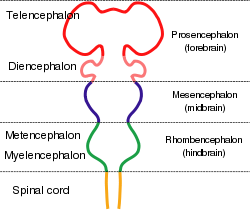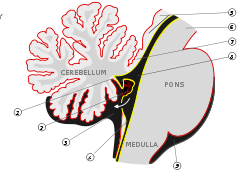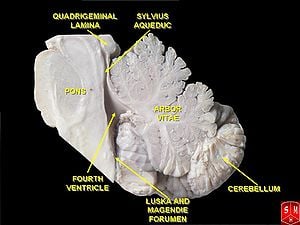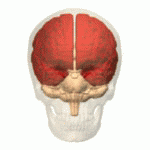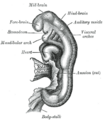Difference between revisions of "Hindbrain" - New World Encyclopedia
Rick Swarts (talk | contribs) (added article from wikipedia and credit/category tags) |
Rick Swarts (talk | contribs) |
||
| Line 27: | Line 27: | ||
The caudal rhombencephalon has been generally considered as the initiation site for neural tube closure.<ref>[http://www.springerlink.com/content/f3fc056wde57c1yc/ SpringerLink - Journal Article<!-- Bot generated title —>]</ref> | The caudal rhombencephalon has been generally considered as the initiation site for neural tube closure.<ref>[http://www.springerlink.com/content/f3fc056wde57c1yc/ SpringerLink - Journal Article<!-- Bot generated title —>]</ref> | ||
| + | |||
| + | ==Overview== | ||
| + | [[Image:Chimp Brain in a jar.jpg|thumb|alt=A brain floating in a liquid-filled glass jar. Yellowing of the handwritten labels on the jar give the object an antique appearance.|A [[chimpanzee]] brain]] | ||
| + | All [[vertebrate]]s and most [[invertebrate]]s have an enlarged mass of nervous tissue that constitute an [[organ (anatomy)|organ]] known as a [[brain]]. While [[sponge]]s lack [[nervous system]]s and the nervous system of such radially symmetric symmetric animals as [[ctenophores]] (comb jellies) and [[cnidarians]] (e.g., anemones, hydras, corals. and jellyfishes) is but a diffuse network of isolated cells (Ruppert et al. 2004), all bilateral animals—with the exception of a few types of worms—have a nervous system containing a brain, a central cord (or two cords running in [[parallel (geometry)|parallel]]), and nerves radiating from the brain and central cord. In [[vertebrate]]s, the brain is the most complex organ in the body. Together the [[brain]] and [[spinal cord]] of vertebrates comprise what is known as the [[central nervous system]] (CNS), with the brain contained in the cranial subcavity (the skull), and the spinal cord in the spinal cavity (within the vertebral column). The human brain itself averages about 86 billion neurons (Gonzalez 2012). | ||
| + | |||
| + | [[File:Cerebrum animation small.gif|thumb|left|Location of the human cerebrum (red).]] | ||
| + | Vertebrate brains are characterized by three primary divisions: hindbrain (or rhombencephalon), midbrain (or mesencephalon), and forebrain (or prosencephalon). The '''hindbrain''' includes the [[medulla oblongata]], the [[pons]], and the [[cerebellum]]. The hindbrain was the major component of early brains, as seen via casts of fossil agnathans, and remains the major part of [[fish]] brains today. The '''midbrain''' primarily is composed of the [[optic tectum]], which processes and receives visual information. The midbrain, pons, and medulla also are collectively referred to as the [[brainstem]]. The '''forebrain''' is dominant in terrestrial vertebrates, where it is the center of the processing sensor information. The forebrain of reptiles, amphibians, birds, and mammals is commonly divided into two regions: the '''diencephalon''', which consists of the [[hypothalamus]] and the [[thalamus]], and the '''telencephalon''', or "end brain," which in mammals is called the '''cerebrum''' (Raven et al. 2008). The same number of brain divisions are found in most vertebrates, with the notable exception of a lack of a cerebellum in both [[hagfish]]es and lampreys (Northcutt 2002). | ||
| + | |||
==Myelencephalon== | ==Myelencephalon== | ||
Revision as of 00:27, 8 December 2013
| Brain: Rhombencephalon | ||
|---|---|---|
| Diagram depicting the main subdivisions of the embryonic vertebrate brain. These regions will later differentiate into forebrain, midbrain and hindbrain structures. | ||
| Scheme of roof of fourth ventricle. | ||
| Gray's | subject #187 767 | |
| NeuroNames | hier-531 | |
| MeSH | Rhombencephalon | |
| Dorlands/Elsevier | r_12/12709581 | |
The rhombencephalon (or hindbrain) is a developmental categorization of portions of the central nervous system in vertebrates. It includes the medulla, pons, and cerebellum. Together they support vital bodily processes.[1]
The rhombencephalon can be subdivided in a variable number of transversal swellings called rhombomeres. In the human embryo eight rhombomeres can be distinguished, from caudal to rostral: Rh8-Rh1. Rostrally, the isthmus demarcates the boundary with the midbrain or mesencephalon.
A rare disease of the rhombencephalon, "rhombencephalosynapsis," is characterized by a missing vermis resulting in a fused cerebellum. Patients generally present with cerebellar ataxia.
The caudal rhombencephalon has been generally considered as the initiation site for neural tube closure.[2]
Overview
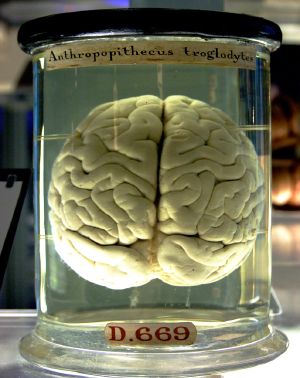
All vertebrates and most invertebrates have an enlarged mass of nervous tissue that constitute an organ known as a brain. While sponges lack nervous systems and the nervous system of such radially symmetric symmetric animals as ctenophores (comb jellies) and cnidarians (e.g., anemones, hydras, corals. and jellyfishes) is but a diffuse network of isolated cells (Ruppert et al. 2004), all bilateral animals—with the exception of a few types of worms—have a nervous system containing a brain, a central cord (or two cords running in parallel), and nerves radiating from the brain and central cord. In vertebrates, the brain is the most complex organ in the body. Together the brain and spinal cord of vertebrates comprise what is known as the central nervous system (CNS), with the brain contained in the cranial subcavity (the skull), and the spinal cord in the spinal cavity (within the vertebral column). The human brain itself averages about 86 billion neurons (Gonzalez 2012).
Vertebrate brains are characterized by three primary divisions: hindbrain (or rhombencephalon), midbrain (or mesencephalon), and forebrain (or prosencephalon). The hindbrain includes the medulla oblongata, the pons, and the cerebellum. The hindbrain was the major component of early brains, as seen via casts of fossil agnathans, and remains the major part of fish brains today. The midbrain primarily is composed of the optic tectum, which processes and receives visual information. The midbrain, pons, and medulla also are collectively referred to as the brainstem. The forebrain is dominant in terrestrial vertebrates, where it is the center of the processing sensor information. The forebrain of reptiles, amphibians, birds, and mammals is commonly divided into two regions: the diencephalon, which consists of the hypothalamus and the thalamus, and the telencephalon, or "end brain," which in mammals is called the cerebrum (Raven et al. 2008). The same number of brain divisions are found in most vertebrates, with the notable exception of a lack of a cerebellum in both hagfishes and lampreys (Northcutt 2002).
Myelencephalon
Rhombomeres Rh8-Rh4 form the myelencephalon.
The myelencephalon forms the medulla oblongata in the adult brain; it contains:
- a portion of the fourth ventricle,
- the glossopharyngeal nerve (CN IX),
- vagus nerve (CN X),
- accessory nerve (CN XI),
- hypoglossal nerve (CN XII),
- and a portion of the vestibulocochlear nerve (CN VIII).
Metencephalon
Rhombomeres Rh3-Rh1 form the metencephalon.
The metencephalon is composed of the pons and the cerebellum; it contains:
- a portion of the fourth ventricle,
- the trigeminal nerve (CN V),
- abducens nerve (CN VI),
- facial nerve (CN VII),
- and a portion of the vestibulocochlear nerve (CN VIII).
Evolution
The hindbrain is homologous to a part of the arthropod brain known as the sub-oesophageal ganglion, in terms of the genes that it expresses and its position in between the brain and the nerve cord.[3] On this basis, it has been suggested that the hindbrain first evolved in the Urbilaterian - the last common ancestor of chordates and arthropods - between 570 and 555 million years ago.[3][4]
Additional images
ReferencesISBN links support NWE through referral fees
- Haycock DE (2011). Being and Perceiving. Manupod Press. ISBN 978-0-9569621-0-2.
- ↑ Brain atlas - Hindbrain. Lundbeck Institute - Brain explorer. Retrieved 2013-06-04.
- ↑ SpringerLink - Journal Article
- ↑ 3.0 3.1 Ghysen A (2003). The origin and evolution of the nervous system. Int. J. Dev. Biol. 47 (7–8): 555–62.
- ↑ Haycock, DE Being and Perceiving
External links
- NIF Search - Rhombencephalon via the Neuroscience Information Framework
Template:Medulla Template:Pons Template:Fourth ventricle Template:Cerebellum
Credits
New World Encyclopedia writers and editors rewrote and completed the Wikipedia article in accordance with New World Encyclopedia standards. This article abides by terms of the Creative Commons CC-by-sa 3.0 License (CC-by-sa), which may be used and disseminated with proper attribution. Credit is due under the terms of this license that can reference both the New World Encyclopedia contributors and the selfless volunteer contributors of the Wikimedia Foundation. To cite this article click here for a list of acceptable citing formats.The history of earlier contributions by wikipedians is accessible to researchers here:
The history of this article since it was imported to New World Encyclopedia:
Note: Some restrictions may apply to use of individual images which are separately licensed.
